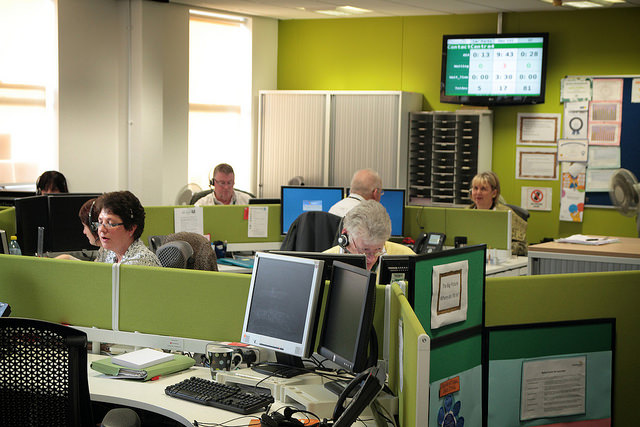Connecting with Customers: RPA in the Front Office
Share at:

Robotic process automation (RPA) is most commonly used to automate tedious, repetitive, and time-consuming back office activities, such as order or claims processing, copy-paste tasks, and data migration. These areas of automation provides companies with numerous value propositions such as enhanced efficiency, reduction in operational costs, and increased communication and collaboration across the entire value chain, all of which allow companies to leverage these benefits into a higher overall level of functionality and productivity.
But it is important to remember what happens to one side of the equation impacts the other, and modifications to back office processes can impact the front office because employees will have more time to focus on improving customer engagement, satisfaction, and retention. If RPA can help streamline back office processes - which are primarily operations based - how can RPA assist in automating the front office? How would RPA work in this sphere and what results can you expect?
Let's review how RPA can be deployed in the front office, the benefits of such deployment, and how RPA allows for collaboration between front office employees and the back office robots in order to help companies develop more meaningful and productive relationships with their customers.
Why Front Office Automation?
The customer is an essential part to the success of every business. While back office automation is important in order to alleviate strain and provide support to the front office, front office automation can completely transform how companies interact, communicate, and engage with their customers.
In an interview with the Institute for Robotic Process Automation (IRPA), David Brain, the Global Head of Process Robotics & Innovations Labs Product Lead of Sutherland Innovation Labs, suggests that RPA in the front office can: "assist your agent, making them more productive and improving your customer experience with shorter transaction times, reducing manual errors and avoiding the highly irritating repeat questions for the same information. It can also open up new channels of communication on your existing systems such as responding to customer’s balance enquiries by text.”
The benefits of front office automation are two-fold: facilitating tasks for which front office employees are responsible, automation creates the opportunity to concentrate on developing and growing relationships with customers, who then in turn are more apt to transform from one-time customers into repeat, long-term clients.
Deloitte elaborates further on the benefits that automating the front office can provide for the customer, suggesting that many companies, even banks and insurance companies, are using RPA to focus “a lot of attention on the front-end and on improving the customer experience, deriving a single view of the customer and their transaction history, and ensuring that customer’s interactions...are satisfactory regardless of the channel.”
RPA in the front office is crucial since it allows employees in the front office to emphasize what’s really important: fostering more valuable customer engagement with new and existing clients.
How RPA Fits into the Front Office
We know that automating the front office has the ability to improve the company-customer relationship, but let’s consider how exactly RPA can empower employees to do so and the holistic benefits of RPA within this space.
Shorter transaction times: Especially important for the front office is the time it takes to address a customer’s questions. Delivering customer-facing services in a timely manner is crucial, especially for call centers that depend on customer satisfaction. With RPA, tasks that would normally be done by a human employee can be done much faster through automation and clients can be contacted in a more efficient manner. RPA can also help employees tackle current backlogs and large volumes of newly incoming requests. Its use will increase the productivity of employees, allowing them to focus on the customer.
Enhanced communication: RPA can be used in the front office to manage customer interactions and communication. It can be used to control a customer contact schedule, triggering reminders when it is time for employees to follow up with customers, or to alert employees if a customer has submitted a complaint. At the same time, RPA can send automated messages to customers regarding, for example, new service or product offerings. Enhanced levels of communication foster a greater understanding of your customers - their wants, needs, and desires, and how best to position products to satisfy those needs.
Significant error reduction: RPA software robots drastically increase accuracy, regardless of whether they are deployed in the front office or the back. Once properly programmed and mapped, robots will be able to execute and streamline a number of actions without the potential for human error. For example, customer service agents often have to navigate between multiple systems during the course of a single call in order to access stored data, record new information, and answer questions for a customer. This process is not only time consuming but also prone to errors. By automating the transfer of data and allowing information to be accessed more easily in one place, RPA will allow employees to provide more accurate services, thereby reducing the number of complaints received from clients.
Connecting the Front and Back Offices
The benefits of RPA in both the front office and the back office are obvious. By connecting the back office and the front, there can be optimized collaboration between the software robots in the background and human employees working in the front office, a model resulting in enhanced customer service. This partnership will give employees the support needed to allow them focus on valuable, customer-facing tasks. Individuals will be able to provide more timely and accurate services, advancing existing connections with clients and also acquiring new customers. Human employees and RPA software robots working alongside will empower businesses to leverage the best of both worlds - the efficiency and accuracy of automation with the personalized touch of human-to-human interaction - and increase the overall performance delivered to customers.

Content Developer, Trekk
Get articles from automation experts in your inbox
SubscribeGet articles from automation experts in your inbox
Sign up today and we'll email you the newest articles every week.
Thank you for subscribing!
Thank you for subscribing! Each week, we'll send the best automation blog posts straight to your inbox.



